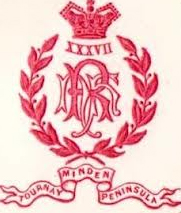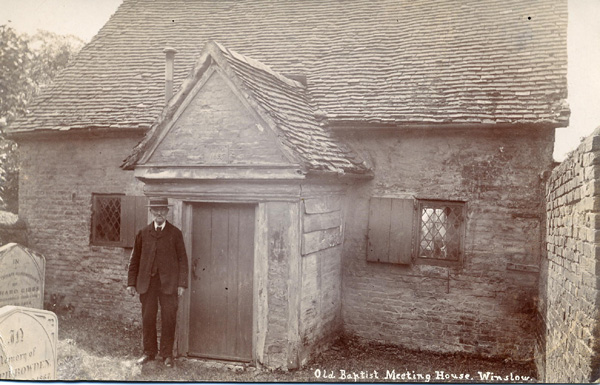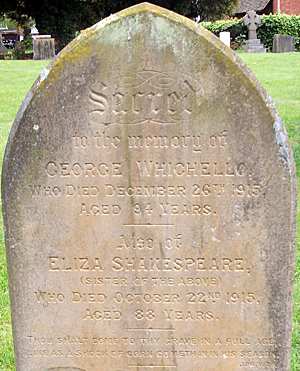
Joseph Whichello of Winslow and the Indian Mutiny (1857-58)
by Ed Grimsdale
The Bucks Herald claimed on 28 Dec 1907 that Colour-Sergeant Joseph Whichello, formerly of the 37th Foot and a native of Winslow, was, as far as the paper knew, the sole survivor of the Indian Mutiny who remained alive in Buckinghamshire. In 1907, he was living at Great Horwood.
Joseph had been honoured a few days before through being invited by the Daily Telegraph to attend a Christmas banquet given at the Royal Albert Hall in London.
(A fortnight later, the paper published an apology to Mr George Stuchbery of Hillesden – the village’s Vicar, the Rev. C. H. Hopper had written to say that George, too, was an Indian Mutiny survivor recognised by the Daily Telegraph. Old soldiers too infirm to travel to London, such Mr Stuchbery, had been sent Christmas hampers by the paper.)
 Joseph Whichello (he was known as Whichells whilst serving in the British Army) was born in Devizes on 12 Feb 1828, came to Winslow as a child, and became a bricklayer. Joseph volunteered for service on 15 Sep 1846 at Fenny Stratford. After joining the 37th Foot, he served in Ceylon for 10 years and then his regiment was transferred to India at the time of the Mutiny. By that time, Whichello was a corporal. Whichello was wounded at Arrah (Dinapur) in Bihar on 29 July 1857, having reached the rank of Sergeant that April.
Joseph Whichello (he was known as Whichells whilst serving in the British Army) was born in Devizes on 12 Feb 1828, came to Winslow as a child, and became a bricklayer. Joseph volunteered for service on 15 Sep 1846 at Fenny Stratford. After joining the 37th Foot, he served in Ceylon for 10 years and then his regiment was transferred to India at the time of the Mutiny. By that time, Whichello was a corporal. Whichello was wounded at Arrah (Dinapur) in Bihar on 29 July 1857, having reached the rank of Sergeant that April.
(Rebellion had broken out amongst the garrisons of Dinapur on 25 July. The rebels rushed towards the city of Arrah and were joined by other rebellious elements. Mr Boyle in Arrah had already prepared his house for defence against such attacks - fortunately he possessed expertise as he was a railway engineer. As the rebels approached Arrah, all its European residents took refuge in Mr. Boyle's compound. A siege ensued but 50 loyal sepoys defended the house against artillery and musketry fire from the rebels. On 27 July 400 or 500 men were sent out from Dinapur to relieve those holed up in Arrah, but this force, including Sergeant Whichello, was ambushed by the rebels about a mile away from Boyle’s siege house and severely defeated. About half of the men were slain and others, including Joseph Whichello, were injured. The British Army was forced to withdraw.)
Later in 1864, he became a Colour Sergeant on loan to the Pembroke Rifle Volunteers. Whichello’s service papers indicate that he was discharged from the Pembroke brigade in November 1867. Whichello would have been nearing 80 years of age when he attended the Daily Telegraph’s 50th anniversary dinner.
Seregeant Whichello’s service medals were sold in auction in 2008 for £700 by the auction house DNW, and it is from its on-line archive that many details of Joseph’s service have been gleaned.
Notes (thanks to Glen Gaetjens for additional information)
 Members of the Whichello family are first recorded at Winslow in the late 18th century. Joseph was the brother of George Whichello, postman and Baptist, who can be seen in this photo outside Keach's Chapel. George Whichello left £100 in his will of 1914, to be invested and the proceeds used to help the elderly poor. This Charity was wound up in 1990 and the funds transferred to the Winslow Charities. He was a tenant of two cottages in Horn Street and a neighbour and friend of Thomas Lee, saddler for almost fifty years. Sadly, Thomas Lee committed suicide in March 1890, a little time after the death of his wife. George Whichello, by then a post-office pensioner, had been looking out for his friend, whom he knew to have been depressed, and every morning he’d been in the habit of looking at 8.15am to see if there was smoke coming from Lee’s chimney, i.e that he was up, about and looking after himself. On walking into Lee’s unlocked house at 9.00am, Whichello knew something was wrong as Lee’s working apron was draped over a chair. George found the body in Lee’s bedroom.
Members of the Whichello family are first recorded at Winslow in the late 18th century. Joseph was the brother of George Whichello, postman and Baptist, who can be seen in this photo outside Keach's Chapel. George Whichello left £100 in his will of 1914, to be invested and the proceeds used to help the elderly poor. This Charity was wound up in 1990 and the funds transferred to the Winslow Charities. He was a tenant of two cottages in Horn Street and a neighbour and friend of Thomas Lee, saddler for almost fifty years. Sadly, Thomas Lee committed suicide in March 1890, a little time after the death of his wife. George Whichello, by then a post-office pensioner, had been looking out for his friend, whom he knew to have been depressed, and every morning he’d been in the habit of looking at 8.15am to see if there was smoke coming from Lee’s chimney, i.e that he was up, about and looking after himself. On walking into Lee’s unlocked house at 9.00am, Whichello knew something was wrong as Lee’s working apron was draped over a chair. George found the body in Lee’s bedroom.
Joseph Whichello and his wife Hannah (born at Hammersmith) were living at Great Horwood in 1901. Joseph's marriage was recorded in the Derby Mercury of 16 Nov 1859: "At Ashborne on 7th Nov: Mr. Joseph Whichello, Sergeant in the 37th Regiment of Foot, to Miss Hannah Dally, of Canterbury." He was an instructor to the Pembroke Rifles at Milford Haven in 1871. After leaving the army he had a career as a workhouse master: he was at Winchcombe, Gloucs, in 1881. Unfortunately, Joseph was reprimanded at an inquest in 1890 into the death of one of inmates at Winchcombe. "He had laid himself open to a charge of misdemeanour," concluded the coroner after the master had released the body of Cox to his family without having secured a cause of death certificate from the Union’s doctor. Joseph was working as master of the Workhouse of Bray in Berkshire in 1891.
 George and Joseph’s sister was Eliza Whichello, born in London in 1827. She married the colourful tailor Samuel Shakespear(e) (he was probably born without the terminal 'e') in Winslow in 1868. Shakespeare may have been born in the Midlands. Certainly, he had served in the 48th Regiment of Foot before arriving in Winslow. In Winslow, he proved to be a hot-head, and was convicted thrice of drunken behaviour: in Richard Lomath’s public house (1866 – with riotous behaviour – Shakespeare broke glass windows in the Winslow lock-up), in the Chandos Arms (1867, again with riotous behaviour) and finally in the Market Square in 1873. Samuel Shakespeare died in Winslow on 7 Jan 1903 aged 72. Eliza and George died within two months of each other in 1915 (see right).
George and Joseph’s sister was Eliza Whichello, born in London in 1827. She married the colourful tailor Samuel Shakespear(e) (he was probably born without the terminal 'e') in Winslow in 1868. Shakespeare may have been born in the Midlands. Certainly, he had served in the 48th Regiment of Foot before arriving in Winslow. In Winslow, he proved to be a hot-head, and was convicted thrice of drunken behaviour: in Richard Lomath’s public house (1866 – with riotous behaviour – Shakespeare broke glass windows in the Winslow lock-up), in the Chandos Arms (1867, again with riotous behaviour) and finally in the Market Square in 1873. Samuel Shakespeare died in Winslow on 7 Jan 1903 aged 72. Eliza and George died within two months of each other in 1915 (see right).
The Whichellos' mother, Margaret (nee Porter), was baptised in Odiham, Hants on 22 Feb 1789, and married John Whichell (sic) of Cripplegate (London) at Odiham on 27 July 1809. She was recorded in Winslow in 1841 with her three children (a probable older son William, b.c.1813, didn't come with her to Winslow, and later emigrated to Australia) and in 1851 as a charwoman, and died "of natural causes" in Winslow on 25 March 1869, aged 82.
Her husband John, a currier, was baptised 16 Aug 1772 at Winslow, son of Abiel Whichello (who originated from Bicester) and Mary, nee Southam (1740-1795); she was the daughter of Ferdinando Southam the attorney (bankrupted in 1761) who lived at Brook Hall and then in the Market Square at the building which is now numbers 21 and 23 (now Amberdown House and Jennie Wren's Tea Room).
John's brother Ferdinando Whichello is listed as a hair dresser at Winslow in 1798. On 5 Dec 1831 he was scheduled to appear at the court of insolvent debtors at Aylesbury, described as "formerly of Stony Stratford, late of Winslow, since of Stony Stratford, Hair-Dresser" (London Gazette, 11 Nov 1831).
See also:
